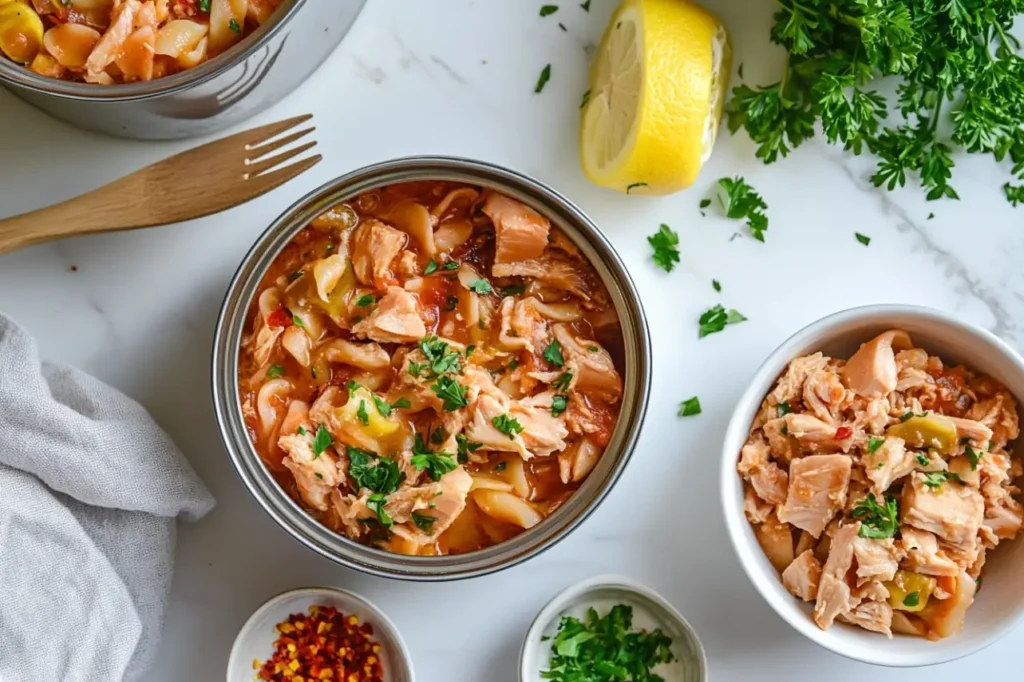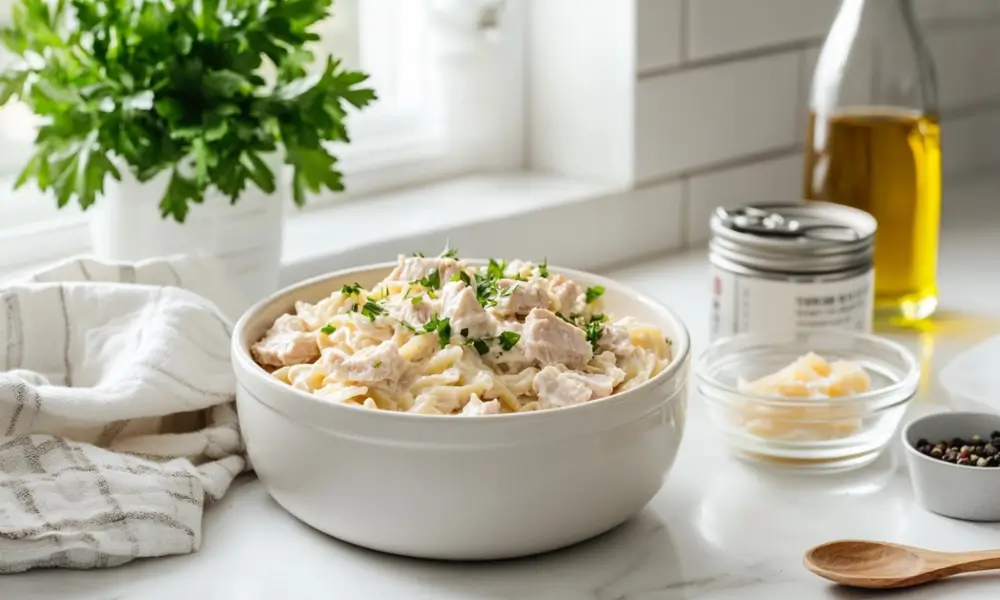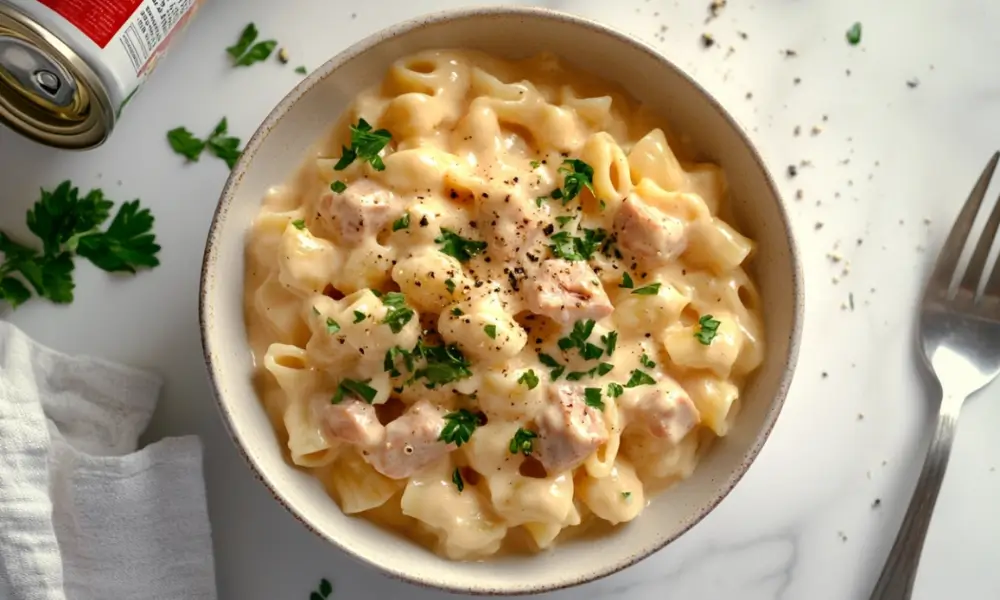Let’s talk about Tuna Helper! You’ve probably seen it on store shelves or maybe even tried it as a quick and satisfying meal. But here’s the thing – there’s so much more you can do with it than just following the box instructions. Whether you’re a college student looking for budget-friendly meals or a busy parent trying to whip up dinner in a flash, Tuna Helper has your back. And, yes, we’re going to answer the big question today: “How many cans of tuna do you need for Tuna Helper?” Spoiler alert: it’s not always as straightforward as the box might suggest!
The Science Behind Tuna Helper’s Popularity

A Peek Into Tuna Helper’s History
Back in the 1970s, when convenience foods were becoming all the rage, Tuna Helper entered the scene like a culinary superhero. It gave families a quick, affordable, and delicious way to stretch their groceries. Think about it – with just a box of Tuna Helper and a couple of cans of tuna, you’ve got a warm, hearty meal ready to go.
“Tuna Helper was more than a box meal; it became a kitchen staple in homes across America.”
How Tuna Became the Star Ingredient
Why tuna, though? Good question! Tuna is cheap, versatile, and packed with protein. Plus, it has a long shelf life, which makes it the perfect pantry hero. It’s like the friend who always shows up when you need them the most. Pair it with the creamy, cheesy goodness of Tuna Helper, and you’ve got a match made in food heaven. Tuna is not only practical but also adds a unique flavor that complements the meal perfectly.
The Role of Convenience in Busy Kitchens
Let’s face it, life is busy. Sometimes, you don’t have time to plan elaborate meals or spend hours in the kitchen. That’s where Tuna Helper shines. It’s the ultimate convenience meal – quick, easy, and delicious. Plus, it’s kid-approved, which is always a win. Tuna Helper has become a reliable choice for nights when you crave a comforting meal without the hassle. It’s like having a convenient kitchen helper in a box..
Exploring Unique Tuna Ratios for Perfect Flavor
Beyond the Box: Creative Tuna Measurements
The box instructions usually call for one can of tuna (about 5 ounces). But who says you have to stick to that? Want a meatier dish? Go ahead and toss in two cans. Prefer something lighter? Use half a can. The beauty of Tuna Helper is its flexibility. You’re the boss in the kitchen! Experimenting with tuna quantities can open up a world of flavors. For a more flavorful and indulgent dish, opt for canned tuna in olive oil instead of water-packed tuna. The extra oil enhances the creaminess.
How the Tuna-to-Pasta Ratio Impacts Taste
Here’s the deal: the tuna-to-pasta ratio is the secret sauce (well, not literally). Too little tuna, and your dish might feel like it’s missing something. Too much tuna, and it can overpower the creamy flavors of the sauce. The sweet spot? About 1.5 cans for most people. It’s just enough to keep things balanced while still delivering that signature tuna taste. Imagine it like a duet – the pasta and tuna should harmonize rather than compete for the spotlight.
Scaling Up or Down for Different Family Sizes
Cooking for one? Use half the box and a single can of tuna. Feeding a crowd? Double the box and throw in 3-4 cans of tuna. Tuna Helper is like the chameleon of dinner recipes – it adapts to whatever you need. Whether you’re making a cozy meal for yourself or a feast for your family, Tuna Helper has you covered. The best part? It’s budget-friendly and stretches easily to feed more mouths.
Beyond Cans: Tuna Innovations to Try

Pouch Tuna vs. Canned Tuna: Which Works Best?
Did you know you don’t have to stick to canned tuna? Tuna in pouches is a great alternative! It’s fresher, less messy, and comes in a variety of flavors. Want to spice up your Tuna Helper? Try a pouch of sweet and spicy tuna. Craving something bold? Garlic herb tuna can take your dish to the next level. Pouch tuna also has a firmer texture, which can make your Tuna Helper feel a bit more gourmet.
Smoked Tuna and Other Gourmet Options
If you’re feeling fancy, smoked tuna is a game-changer. It adds a rich, smoky flavor that makes your Tuna Helper taste like it came from a high-end restaurant. It’s like turning a regular car into a luxury ride – same basic function, but way more stylish! Smoked tuna also pairs beautifully with creamy sauces and crunchy toppings, elevating your meal to something truly special.
Sustainable Tuna Choices for Ethical Cooking
These days, more people are paying attention to where their food comes from. If sustainability matters to you, look for tuna brands with certifications like MSC (Marine Stewardship Council). Supporting sustainable fishing practices helps protect the oceans, so you can feel good about your meal. Plus, many sustainable brands offer higher-quality tuna that can enhance the flavor of your dish.
Transforming Tuna Helper Into a Gourmet Experience
Gourmet Ingredients That Pair Beautifully with Tuna
Who says Tuna Helper has to be basic? Add gourmet touches like capers, artichoke hearts, or sun-dried tomatoes. These simple additions can take your meal from ordinary to extraordinary. Think of it like accessorizing an outfit – a little bling can make all the difference! Adding a drizzle of truffle oil or a sprinkle of fresh dill can make your dish feel like something out of a fancy restaurant.
Turning Tuna Helper into a Casserole Bake
Here’s a fun twist: after cooking your Tuna Helper, transfer it to a casserole dish, sprinkle some breadcrumbs and cheese on top, and bake it for 10 minutes. Boom! You’ve got a golden, crispy-topped masterpiece. It’s like giving your Tuna Helper a makeover – same delicious base, but with a whole new look and texture. This method also works great if you’re serving guests and want to impress them with minimal effort.
How to Add Layers of Texture to Tuna Helper
Tuna Helper is creamy and delicious, but it can use a bit of crunch. Add toasted breadcrumbs, crushed potato chips, or even roasted nuts as a topping. It’s like giving your dish a little personality – crispy, creamy, and oh-so-satisfying. For an extra kick, try mixing in some spicy crushed red pepper flakes or a squeeze of lemon juice to brighten up the flavors.
Nutrition Facts for Tuna Helper
| Component | Amount Per Serving |
|---|---|
| Calories | 360 |
| Protein | 18g |
| Total Fat | 11g |
| Sodium | 900mg |
| Carbohydrates | 45g |
Of course, these numbers can vary depending on how much tuna and what other ingredients you add. But hey, a little indulgence every now and then is totally worth it, right?
And that’s just the start! Tuna Helper offers a world of possibilities if you’re willing to get creative in the kitchen. Stay tuned for Part 2, where we’ll dive into more tips, tricks, and unique ideas to make your Tuna Helper truly unforgettable.
Solving Common Tuna Helper Complaints with Creativity

What to Do If Your Tuna Helper Is Too Bland
Let’s be honest, sometimes Tuna Helper straight out of the box can taste a little… underwhelming. But don’t worry – this is your chance to play chef! A quick fix is to add seasoning to amp up the flavor. Experiment with garlic powder, onion powder, or a hint of smoked paprika for extra flavor. Feeling adventurous? Toss in a splash of hot sauce or a pinch of cayenne for some heat. Bland Tuna Helper is like a blank canvas – with a little effort, you can turn it into a masterpiece.
Adjusting for Overly Salty Tuna Helper
Ever taken a bite and thought, “Whoa, that’s salty”? It happens, especially if you’re using tuna packed in brine or salty canned goods. The solution? Balance it out. Add unsalted ingredients like plain yogurt, sour cream, or even extra pasta to dilute the saltiness. Squeeze in a bit of lemon juice – it might sound strange, but the acidity can actually mellow out the salty flavor. Think of it as balancing a seesaw: too salty on one side? Add something mild to even things out.
Fixing Consistency Issues: Too Dry or Too Soupy
Consistency can make or break your Tuna Helper. Too dry? Add a splash of milk or broth while stirring. You can even mix in a dollop of cream cheese for extra richness. Too soupy? Allow it to simmer uncovered for a few minutes to let the liquid reduce. Cooking is all about finding that perfect balance. It’s a little like Goldilocks – not too dry, not too soupy, but just right.
Surprising Alternatives to Tuna in Tuna Helper
Using Salmon for a Richer Flavor
What if tuna isn’t your thing? No problem – swap it out for salmon! Canned salmon works beautifully in Tuna Helper and adds a richer, meatier flavor. Plus, it’s packed with omega-3s, so you’re getting an extra health boost. It’s like giving your dish an elegant twist – same comfort food base, but a little fancier.
Plant-Based Options: Chickpeas, Jackfruit, and More
If you’re vegetarian or simply looking to switch things up, try plant-based alternatives. Chickpeas are an excellent option – they’re hearty, nutritious, and soak up the flavors of the dish. Jackfruit is another surprising substitute; it mimics the texture of shredded meat, making it perfect for Tuna Helper recipes. Who says comfort food can’t be plant-friendly? 🌱💚
Incorporating Leftover Proteins into Tuna Helper
Got leftover chicken, turkey, or even shrimp? Toss them into your Tuna Helper! This is a great way to avoid food waste while adding a little variety to your meals. Imagine a surf-and-turf version with shrimp and tuna – it’s like bringing a restaurant experience right into your kitchen.
Pairing Tuna Helper with Perfect Side Dishes
Salads That Complement Tuna Helper’s Flavors
A fresh, crisp salad is the perfect sidekick for Tuna Helper. Consider it the perfect sidekick to your main dish. A simple green salad with a zesty vinaigrette can cut through the creaminess of the dish, balancing the flavors beautifully. Or, for a heartier option, try a Mediterranean salad with cucumbers, olives, and feta. It’s all about contrast – creamy meets crunchy, rich meets refreshing. 🥗
The Best Bread and Rolls to Serve Alongside
What’s better than dipping warm, crusty bread into a creamy sauce? Not much! Serve your Tuna Helper with garlic bread, dinner rolls, or even a baguette. If you’re feeling fancy, make herb butter to spread on the bread – it’s a small touch that goes a long way. Bread isn’t just a side dish here; it’s part of the experience. 🍞
Creative Beverage Pairings for a Complete Meal
Pairing beverages with Tuna Helper might sound unusual, but it can elevate your meal. For a family-friendly option, serve iced tea or sparkling water with a slice of lemon. Hosting adults? A crisp white wine like Sauvignon Blanc or a light beer pairs wonderfully with the creamy, savory flavors of Tuna Helper. Cheers to making dinner feel special! 🍷🥂
Elevating Tuna Helper with International Flavors
Adding Mediterranean Ingredients: Olives, Feta, and Sundried Tomatoes
If you love bold, tangy flavors, give your Tuna Helper a Mediterranean twist. Add chopped olives, crumbled feta, and a handful of sundried tomatoes. Finish it off with a drizzle of olive oil and a sprinkle of oregano, and suddenly, you’re dining in a cozy Greek taverna. Opa! 🇬🇷
Asian-Inspired Tuna Helper with Soy Sauce and Sesame
Take your Tuna Helper on a trip to Asia! Add a splash of soy sauce, a drizzle of sesame oil, and a sprinkle of green onions. For extra flair, toss in some shredded carrots or snap peas. It’s like giving your comfort food an exotic makeover – same dish, but with a whole new vibe. 🍜
Spicing It Up: Mexican-Inspired Tuna Helper Ideas
Craving something with a little kick? Add diced jalapeños, black beans, and a sprinkle of taco seasoning to your Tuna Helper. Top it off with shredded cheese, avocado slices, and a dollop of sour cream. It’s a fiesta in a bowl! 🌮🔥
Budget-Friendly Hacks for Tuna Helper Enthusiasts
Maximizing Ingredients You Already Have at Home
One of the best things about Tuna Helper is how well it works with pantry staples. Out of milk? Use a little water and butter instead. No tuna? Substitute canned chicken or even diced ham. The key is to get creative with what you have on hand. Your kitchen is like a treasure chest – you just need to dig a little to find the gems. 💎
Making Tuna Helper Stretch for More Servings
If you’re feeding a crowd or just trying to make your meal last longer, there are easy ways to stretch Tuna Helper. Add extra pasta, frozen vegetables, or even rice to bulk up the dish. It’s like turning one meal into two – simple, smart, and satisfying. 🍚
Store Brands vs. Name Brands: Is There a Difference?
Is the name-brand Tuna Helper really better than the store-brand version? Not always! Store brands often taste just as good for a fraction of the cost. If you’re on a budget, give them a try. After all, saving money never goes out of style. 💰
Smart Storage Tips for Leftover Tuna Helper
Proper Refrigeration Techniques for Best Results
Leftovers? No problem. Store your Tuna Helper in an airtight container and pop it in the fridge. It’ll stay fresh for up to three days. Just make sure to reheat it gently to avoid drying it out. The microwave is your friend, but a stovetop reheating with a splash of milk works wonders too. 🥡
The Dos and Don’ts of Freezing Tuna Helper
Yes, you can freeze Tuna Helper! Be sure to let it cool completely before transferring it to a freezer-safe container. When you’re ready to eat, thaw it in the fridge overnight and reheat slowly. The creamy texture might change slightly, but the flavors will still be on point. ❄️
How to Reheat Tuna Helper Without Losing Flavor
Reheating Tuna Helper can be tricky – too much heat and it might dry out. The trick? Add a splash of milk or broth before reheating. This helps restore its creamy consistency. Stir frequently, and you’ll have a dish that tastes just as good as when it was freshly made. 🍲
FAQs About Tuna Helper
1. How many cans of tuna do you need for Tuna Helper?
Most Tuna Helper boxes recommend using one 5-ounce can of tuna. However, you can adjust this based on your preference. If you want a meatier dish, two cans work great, while half a can is enough if you’re looking for a lighter meal.
2. Can I use fresh tuna instead of canned tuna in Tuna Helper?
Absolutely! Fresh tuna can elevate the dish. Simply cook the tuna first by grilling, searing, or baking, then flake it into small pieces before mixing it into the Tuna Helper. It gives the meal a more gourmet feel.
3. What is the best type of canned tuna to use for Tuna Helper?
Both water-packed and oil-packed tuna work well, depending on your preference. Water-packed tuna is lighter and has fewer calories, while oil-packed tuna adds richness and enhances the creaminess of the dish.
4. Can I make Tuna Helper without milk?
Yes, you can substitute milk with alternatives like almond milk, coconut milk, or even plain water mixed with a bit of butter. Another option is to use cream cheese or sour cream to maintain the dish’s creaminess.
5. Can I freeze leftover Tuna Helper?
Yes, you can freeze Tuna Helper. Allow it to cool completely, store it in an airtight container, and freeze for up to three months. To reheat, thaw it overnight in the fridge and reheat on the stovetop or in the microwave with a splash of milk or broth.
6. What vegetables can I add to Tuna Helper?
You can add frozen peas, diced carrots, corn, broccoli, or spinach to Tuna Helper. These vegetables not only add nutrition but also enhance the texture and flavor of the dish.
7. Is Tuna Helper suitable for people on a low-sodium diet?
Tuna Helper can be high in sodium, especially if you use regular canned tuna. To make it low-sodium, opt for low-sodium canned tuna, use unsalted butter, and avoid adding extra salt to the dish.
8. Can I make Tuna Helper gluten-free?
Yes! Use gluten-free pasta and a gluten-free thickening agent for the sauce. Many brands now offer gluten-free versions of Tuna Helper, or you can create your own using a similar recipe.
9. How do I prevent Tuna Helper from drying out?
If your Tuna Helper feels too dry, add a splash of milk, cream, or broth while reheating. Stir well to ensure the sauce becomes creamy again. Cooking it on low heat also helps retain moisture.
10. Can I use other proteins instead of tuna?
Yes, Tuna Helper is versatile! You can substitute tuna with canned chicken, salmon, shrimp, or even plant-based proteins like chickpeas or jackfruit. Each option adds its own unique flavor and texture.
11. Can I make Tuna Helper spicy?
Of course! Add chili flakes, a splash of hot sauce, or diced jalapeños to the dish. Spicy tuna pouches are also an easy way to add heat without extra effort.
12. Can I use dairy-free ingredients in Tuna Helper?
Yes, you can make Tuna Helper dairy-free by using plant-based milk (like almond, soy, or oat milk) and vegan butter. For a creamy consistency, add a dairy-free cheese or cashew cream.
13. How long can I store leftover Tuna Helper in the fridge?
Leftover Tuna Helper can be stored in an airtight container in the refrigerator for up to three days. Make sure to reheat it thoroughly before eating.
14. Is Tuna Helper suitable for meal prep?
Yes, Tuna Helper works well for meal prep! Cook a large batch, portion it into meal prep containers, and store it in the fridge or freezer. Just reheat when you’re ready to eat!
15. Can I make Tuna Helper healthier?
Absolutely! Use whole-grain pasta, low-fat milk, and add plenty of vegetables. You can also opt for tuna packed in water instead of oil to reduce calories and fat.
Got more questions about Tuna Helper? Don’t hesitate to experiment – it’s a flexible dish that’s all about making it your own!
Spice Up Your Tuna Helper Game
Curious about perfecting your Tuna Helper? Learn how to create a creamy, flavorful twist with our guide on Tuna Helper Creamy Pasta. Looking for variety? Check out What Is Beef Sausage for creative protein swaps!
Final Thoughts: Your Guide to Making Tuna Helper Unique
Tuna Helper is more than just a box meal – it’s a canvas for your creativity. Whether you’re adding gourmet ingredients, experimenting with international flavors, or finding ways to make it budget-friendly, there’s no limit to what you can do. The key is to have fun with it. So grab your cans of tuna, roll up your sleeves, and let your imagination run wild. Who knows? You might just create a dish that becomes a new family favorite. Happy cooking! 🍽️


